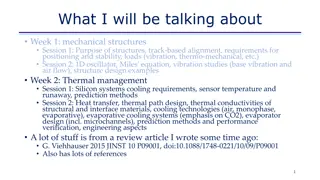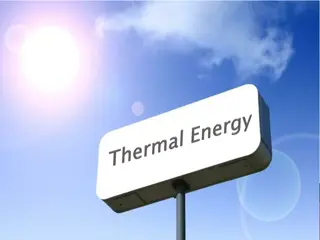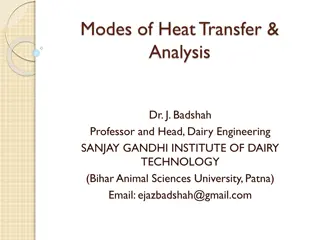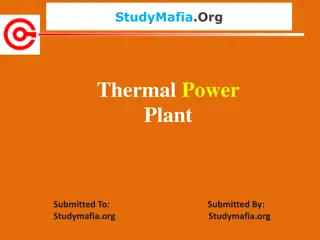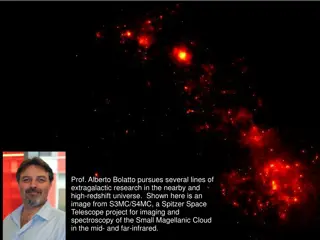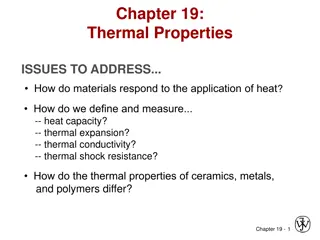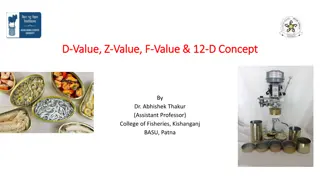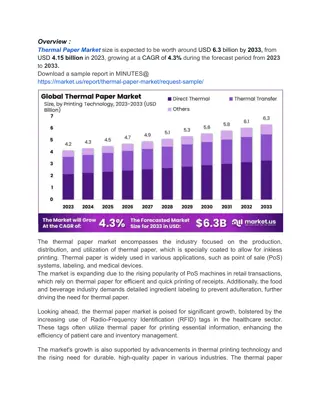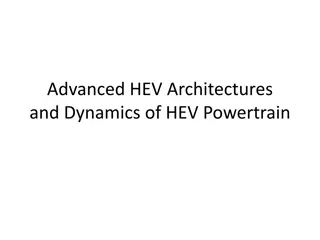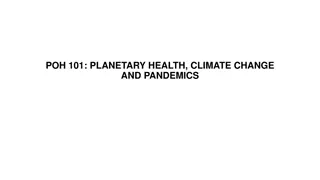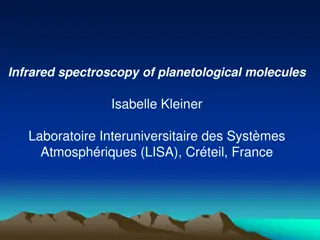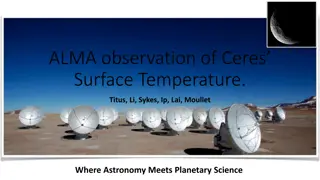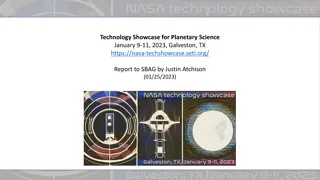A Primer on Planetary Protection for Thermal Engineers
Delve into the realm of planetary protection with this comprehensive primer tailored for thermal engineers by Betsy Pugel, PhD. Explore the intersection of thermal and planetary protection, flight project practicalities, and the crucial components of forward and backward contamination. Gain insights into NASA's mission requirements to safeguard science and the planet, avoiding common misconceptions about planetary protection's scope.
Download Presentation

Please find below an Image/Link to download the presentation.
The content on the website is provided AS IS for your information and personal use only. It may not be sold, licensed, or shared on other websites without obtaining consent from the author.If you encounter any issues during the download, it is possible that the publisher has removed the file from their server.
You are allowed to download the files provided on this website for personal or commercial use, subject to the condition that they are used lawfully. All files are the property of their respective owners.
The content on the website is provided AS IS for your information and personal use only. It may not be sold, licensed, or shared on other websites without obtaining consent from the author.
E N D
Presentation Transcript
A Primer on Planetary Protection for Thermal Engineers Betsy Pugel, PhD Code 546/ Contamination, Coatings and Planetary Protection Engineering Branch Planetary Protection Group Lead, GSFC Betsy.Pugel@nasa.gov TFAWS 2023 TFAWS 2023 - Planetary Protection - Pugel/GSFC/546 1
Today Planetary Protection Basics Planetary Protection Requirements The Intersection of Thermal and Planetary Protection Flight Project Practicalities TFAWS 2023 - Planetary Protection - Pugel/GSFC/546 2
Today Planetary Protection Basics Planetary Protection Requirements The Intersection of Thermal and Planetary Protection Flight Project Practicalities TFAWS 2023 - Planetary Protection - Pugel/GSFC/546 3
What this talk is (and isn t) What this talk is: A fun (hopefully!) and informative way to learn about planetary protection What this isn t: A review of planetary protection policy. A list of what can or cannot/should or should not be used. TFAWS 2023 - Planetary Protection - Pugel/GSFC/546 4
Planetary Protection NASA missions are required to comply with requirements that protect the science and protect the planet, depending on the mission s objectives. TFAWS 2023 - Planetary Protection - Pugel/GSFC/546 5
What Planetary Protection isn t It s not about keeping an eye on the big things... (asteroids impacting Earth) Planetary Defense TFAWS 2023 - Planetary Protection - Pugel/GSFC/546 6
What Planetary Protection is It s about keeping an eye on the little things... (microbes) TFAWS 2023 - Planetary Protection - Pugel/GSFC/546 7
T. Errigo C. Lorentson R. Perry TFAWS 2023 - Planetary Protection - Pugel/GSFC/546 8
The two components of planetary protection FORWARD CONTAMINATION BACKWARD CONTAMINATION 9 TFAWS 2023 - Planetary Protection - Pugel/GSFC/546
FORWARD CONTAMINATION Keeping opportunities open for future science on other planetary bodies noise Ours Or Or Mars? Ours Mars? signal BACKWARD CONTAMINATION TFAWS 2023 - Planetary Protection - Pugel/GSFC/546 10
What do we protect other planets from? The hardiest of the hardy: microbes able to be dormant when the environment was unfavorable and then, emerge from dormancy when conditions were favorable. These are known as bacterial endospores or just spores. 11 TFAWS 2023 - Planetary Protection - Pugel/GSFC/546
Spores and Bioburden Endospores, or spores are the dormant forms of bacteria, able to withstand adverse environmental pressures and reanimate when the conditions are right. When the going gets tough, the tough get sporulating. < 3 microns Note: these are bacterial spores, not mold spores! 12 TFAWS 2023 - Planetary Protection - Pugel/GSFC/546
FORWARD CONTAMINATION Not closing the door on our Earthly civilization when we bring samples back from certain planetary bodies BACKWARD CONTAMINATION TFAWS 2023 - Planetary Protection - Pugel/GSFC/546 13
microbes! Wait, what?! Why? Article IX States Parties to the Treaty shall pursue studies of outer space, including the moon and other celestial bodies, and conduct exploration of them so as to avoid their harmful contamination and also adverse changes in the environment of the Earth resulting from the introduction of extraterrestrial matter and, where necessary, shall adopt appropriate measures for this purpose. conduct exploration of them so as to avoid their harmful contamination TFAWS 2023 - Planetary Protection - Pugel/GSFC/546 14
Today Planetary Protection Basics Planetary Protection Requirements The Intersection of Thermal and Planetary Protection Flight Project Practicalities TFAWS 2023 - Planetary Protection - Pugel/GSFC/546 15
Guiding NASA Policy and Documents Biological Contamination Control for Outbound and Inbound Planetary Spacecraft Roles and Responsibilities NPD 8020.7 Planetary Protection Provisions for Robotic Extraterrestrial Missions Categorization and Requirements NPR 8715.24 Formerly, NPR 8020.12D NID 8020.109A PP Standard Standard Processes for Bioburden Assaying/Processing NASA-STD-8719.PP NASA Technical Handbook for the Microbial Examination of Hardware, in revision Guidance document with engineering information CALL YOUR CALL YOUR NASA-HDBK-6022 NASA Interim Document- Biological Planetary Protection for Human Missions to Mars Roadmap for developing PP Requirements for human missions PP ENGINEER! PP ENGINEER! NID 8715.129 Don t worry, your PP Engineer wrangles all of this! TFAWS 2023 - Planetary Protection - Pugel/GSFC/546 TFAWS 2023 - Planetary Protection - Pugel/GSFC/546 16
TITAN, ENCELADUS GANYMEDE EUROPA CERES IO TFAWS 2023 - Planetary Protection - Pugel/GSFC/546 17
TITAN, ENCELADUS GANYMEDE EUROPA IO Cat II Cat II, III , IV Cat II Cat II Cat II Cat II Cat I Cat II Cat II Cat III & IV Cat II (moon) Cat I or II Cat IV or Cat III Planetary Protection Categorization 18 TFAWS 2023 - Planetary Protection - Pugel/GSFC/546
Categorization NASA Missions are categorized I V for Planetary Protection Categorization Definitions and requirements in NASA Procedural Requirement (NPR) Categorization frames the range of requirements, implementation ranges and verification approaches and depends upon: Target body (moon vs. planet vs. other) Mission Objectives (detecting life? Not detecting life?) Mission Platform (Orbiter? Lander?) Categorization Depends On: Where you re going How you re going to get there What you plan on doing once you get there If you re going back home Code 546/Your PP Engineer is tasked to work with a project to generate these requests and work through requirements development, implementation, and verification. TFAWS 2023 - Planetary Protection - Pugel/GSFC/546 19
Categorization Depends On: Where you re going How you re going to get there What you plan on doing once you get there If you re going back home Categorization Mission Platform Planetary Target Priority Any Not of direct interest for understanding the process of chemical evolution or where exploration will not be jeopardized by terrestrial contamination. No protection of such planets is warranted, and no requirements are imposed. Typical Examples: Undifferentiated, metamorphosed asteroids, Io I Any Of significant interest relative to the process of chemical evolution but only a remote chance that contamination by spacecraft could compromise future investigations. Typical Examples: Venus, Moon, Jupiter, Saturn, Uranus, Uranian satellites, Neptune, Comets, Ceres, Carbonaceous Chondrite Asteroids, Ganymede, Titan, Triton, Pluto/Charon, II Flyby, Orbiter Of significant interest relative to the process of chemical evolution and/or the origin of life and for which scientific opinion provides a significant chance that contamination by spacecraft could compromise future investigations. Typical Examples: Mars, Europa, Enceladus III Lander, Probe IV All Earth Return All Solar System Missions Typical Examples: Restricted = Mars, Europa; Unrestricted: Earth s Moon, Venus, most asteroids and comets TFAWS 2023 - Planetary Protection - Pugel/GSFC/546 V Restricted Earth Return Unrestricted Earth Return 20
Some Examples from Current and Past Missions Category I and II Cat III Cat V, Unrestricted Cat V, Restricted Cat IV 13 cubesats Mars Express TFAWS 2023 - Planetary Protection - Pugel/GSFC/546 *assumed 21
Secondary Payloads and Instruments Secondary Payloads (Cubesats/Small Sats) Are independent missions that need to request their own Categorization, separate from the Primary Mission. Secondaries work with the project/mission to do no harm to the overall planetary protection compliance of the primary mission. Cubesats may have a less stringent categorization assigned to them compared to the primary, dependent upon trajectories and primary mission risk assessments. Instruments and Other Payload Elements conform to the Level 1s assigned to the mission/project as defined in the Categorization letter and as flowed to them by the project. TFAWS 2023 - Planetary Protection - Pugel/GSFC/546 22
PP Requirements Themes At a Glance: Sorted by Category Cat PP Plan Inventory of bulk organic constituents Trajectory Biasing Cleanroom Requirement Burnup and Breakup Analyses Subsidiary Plans Bioassays Bioburden Reduction System Sterilization I II III IV V Requirements as listed in the NPR None Some All/Significant TFAWS 2023 - Planetary Protection - Pugel/GSFC/546 23
Today Planetary Protection Basics Planetary Protection Requirements The Intersection of Thermal and Planetary Protection Flight Project Practicalities TFAWS 2023 - Planetary Protection - Pugel/GSFC/546 24
TITAN, ENCELADUS EUROPA IO Cat II Cat II, III , IV Cat II Cat II Cat II Cat II Cat I Cat II Cat II Cat III & IV Cat II (moon) Cat I or II Cat IV or Cat III Missions where Thermal and Planetary Protection Engineers are most likely to work together 25
Thermal and PP Engineers Join Forces for Category IV MIssions FORWARD Cat PP Plan Inventory of bulk organic constituents Trajectory Biasing Cleanroom Requirement CONTAMINATION Burnup and Breakup Analyses Subsidiary Plans Bioassays Bioburden Reduction System Sterilization I II III IV V Requirements as listed in the NPR None Microbial Inactivation Filtration of Blanket Vents/Exhausts Some BACKWARD CONTAMINATION All/Significant TFAWS 2023 - Planetary Protection - Pugel/GSFC/546 26
Category IV Missions: Do we need to thermally inactivate microbes? Depending on the requirements of the Cat IV mission (Mars, Enceladus, Europa), your planetary protection engineer may talk to you about thermally inactivating microbes before launch. Dry Heat Microbial Reduction DHMR Thermal Inactivation of Microbes Bioburden Reduction What? Non-operational bakeout It could happen at the component, subsystem or system level When? It could happen prior to integration, as a part of TVAC, as a separate bakeout. How? It depends on the What . TFAWS 2023 - Planetary Protection - Pugel/GSFC/546 27
Thermal Inactivation of Microbes You experience it everyday Pasteurization, cooking meat, canned food These all employ process-based methods for reducing organisms in your food. How do you know when it s safe to eat your food? The USDA has developed processes in time and temperature. Many of these are written in law for preservation of public health What temperatures make things safe? 28
Bioburden Reduction in Your Daily Life 63oC 71oC 74oC Here, Salmonella (a living organism) is being reduced by an established process NASA reduces spores by a different established process 29
Heat Microbial Reduction Why do we trust our surgeons? What makes their tools sterile? Sterilization of surgical tools, surgical rooms, medical equipment NIH and CDC have developed processes in time and temperature for sterilization. Many of these are written in law for preservation of public health 30
Heat Microbial Reduction At NASA, we do something similar.. Yes! Yes! No! No! http://solarsystem.nasa.gov/galleries/viking-in- the-oven NASA employs process-based (time and temperature) reduction of microbes. [It s like cooking a hamburger that s stainless steel and going to Mars vs. your stomach] The most common approach is Dry Heat Microbial Reduction (DHMR) 31
Milk, Chicken, Spacecraft and Medical Equipment Spacecraft [NASA, 4-6 log] DHMR Medical Equipment [CDC requirements, 2008 > 7 log] 1000 X X 100 X pastuerizing milk X Time[Minutes] X Mad Cow Disease [WHO] 10 Chicken 7-log reduction in salmonella [USDA] 1 0.1 60 80 100 120 140 160 180 200 oC] Temperature [ 32
Category IV Missions: Blanket Filtration for vents/exhausts Depending on the mission requirements your PPE engineer will work with you to determine optimal sizing of blanket filters. < 3 microns TFAWS 2023 - Planetary Protection - Pugel/GSFC/546 33
Today Planetary Protection Basics Planetary Protection Requirements The Intersection of Thermal and Planetary Protection Flight Project Practicalities TFAWS 2023 - Planetary Protection - Pugel/GSFC/546 34
General Advice for Thermal Folks Working a PP Mission (1) Find out who is the PP Lead --- @ GSFC = 546, elsewhere, PP Engineer If you can t find out easily, reach out to our branch management (Randy Hedgeland or Tina Montt de Garcia) or me. (2) Ask the PP Lead about the PP Category: Has it been formally categorized (usually, this happens in Phase A/B)? If this is a proposal, there will be a pre-proposal informal categorization. (3) If it s Category I or II, don t sweat too much. Your planetary protection lead will ask you about materials details/MIUL. That s about it! (4) If it s Category III or IV, we ll be working with you! Can we take advantage of TVAC cycles for microbial bakeouts (if needed?)? Can we list the PP bakeouts in the ERD and in thermal documents? (that way, no one is surprised!) (5) RESIST THE TEMPTATION TO LUMP PP with CONTAMINATION CONTROL! They have different deliverables, different chains of authority They can be different people, depending on the mission complexity! 35 TFAWS 2023 - Planetary Protection - Pugel/GSFC/546
T. Errigo C. Lorentson R. Perry TFAWS 2023 - Planetary Protection - Pugel/GSFC/546 36
Keep Our Solar System Weird Questions? Contact us! Betsy.Pugel@nasa.gov Randy.J.Hedgeland@nasa.gov Kristina.M.Monttdegarcia@nasa.gov 37 TFAWS 2023 - Planetary Protection - Pugel/GSFC/546
TFAWS 2023 - Planetary Protection - Pugel/GSFC/546 38
Requirements At a Glance Cat PP Plan Inventory of bulk organic constituents Trajectory Biasing Cleanroom Requirement Burnup and Breakup Analyses Subsidiary Plans Bioassays Bioburden Reduction System Sterilization I Mostly documentation + Cleanroom Assembly II III Bioburden-Related Requirements IV V TFAWS 2023 - Planetary Protection - Pugel/GSFC/546 39
What you already know about Spacecraft Assaying Sampling a spacecraft is a bit like your experience with swabbing a nose though here, we are sampling for bacteria vs. viral material Processing is very different! Sampling for Strep Throat (bacteria) Sampling for COVID-19 (viral) TFAWS 2023 - Planetary Protection - 40 NOT CLEARED FOR DISTRIBUTION OUTSIDE CODE 300-Intro to PP Pugel/GSFC/546
We process swabs and wipes using the NASA Standard Assay INCUBATE EXTRACT PLATE HEAT SHOCK outreplicate Sonication in water via vortex mixer Outsporulate Water bath 80oC Solar System Survivor Trypticase Soy Agar (TSA) Aerobically incubated 32oC, 72 hours total Inspect in 24 hr intervals My Pet Spore My Pet Spore NASA Standard Assay 41 TFAWS 2023 - Planetary Protection - Pugel/GSFC/546
My Pet Spore My Pet Spore (2) See if it grows (1) Swab extracted sample onto food It s clean! No growth Plate Plate Reclean or Conduct Bioburden Reduction Process Growth Bring your new pet home and feed it! Incubate Keep feeding it and keep it warm! Incubate 42 TFAWS 2023 - Planetary Protection - Pugel/GSFC/546
Terminology A microscopic organism, such as a bacterium, virus or fungus, unable to be seen with the naked eye and typically composed of a single cell. microorganism Microbe A minute organism, A microorganism Cell Cell The basic organizational unit of an Earth organism; some are composed of many cells, together Spore Eukaryotes Eukaryotes SmallerSpore BacterIA BacterIA Archaea Archaea A dormant form of a bacterial cell smaller than the cell itself Virus Types of organisms: most are single-cell microorganisms, but Eukaryotes can be LARGE and multicellular and bacteria make films and aggregations A parasitic entity composed of RNA and/or DNA, and proteins 43
Log Reduction Log Reduction is not about chopping firewood START With a known level of spores You know this level because you ve sampled and assayed. SELECT A bioburden process that has been well characterized (e.g. NASA Standard Process) APPLYthat process to your hardware with appropriate level of controls. END RESULT: a number of logs of reduction in spores. We know the population reduction due to extensive process development and testing. 44
Relative Size Scales of Microbes Bacteria on the head of a pin there are lots there! and they are not angels 45
Terminology Bacteria Spore Virus ~0.2-10 m ~2-5 m ~100-10 nm Size Range DNA in a circular molecule; cell wall; ribosomes make proteins Can exist in a state of dormancy for long periods; bacterial machinery in storage Needs a host; some can persist almost indefinitely in the environment Unique Features Staphylococcus aureus Streptococcus mitis Bacillus subtilis Anthrax NOT S. mitis Influenza Ebola Bacteriophage T-4 Examples Endospores are not the same as mold or fungal spores: Endospores help bacteria withstand harsh conditions Mold spores and fungal spores are what allow molds and fungi to reproduce 46
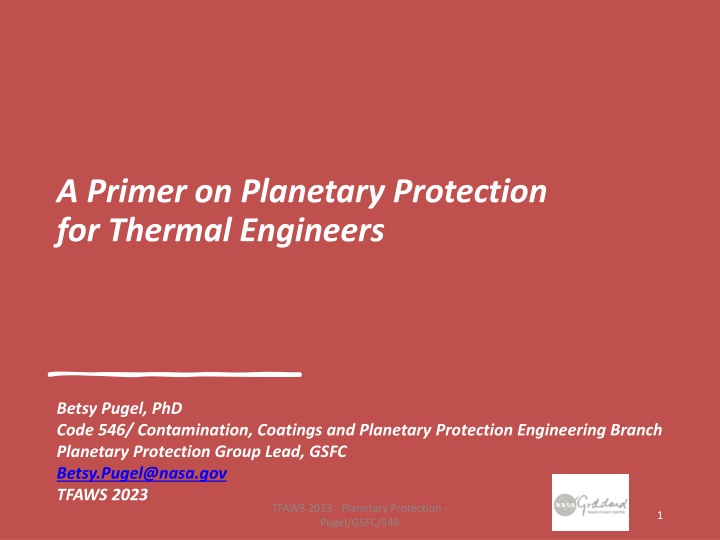

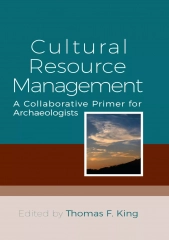
![❤[PDF]⚡ Planetary Ring Systems (Springer Praxis Books)](/thumb/21506/pdf-planetary-ring-systems-springer-praxis-books.jpg)


